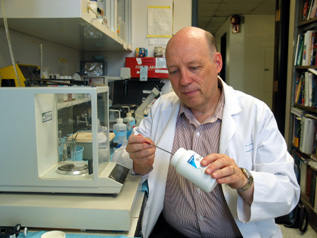 |
David Bylund, Ph.D. |
The adrenergic system is actually a vast and varied regulator of multiple processes, including blood pressure, mental health and well being, energy levels and sleep, pain and addiction.
The partnership will widely expand Addrenex’s drug pipeline from a single product to myriad drugs aimed at medical conditions as diverse as hypertension, attention deficit hyperactivity disorder (ADHD), pain, menopausal symptoms, insomnia and post traumatic stress disorder (PTSD).
The agreement with UNeMed is the company’s second in six months. In July, Addrenex signed a licensing agreement with Sciele Pharma to market clonicel, a drug used to treat hypertension and attention deficit hyperactivity disorder, once it receives approval from the Food and Drug Administration (FDA). The agreement with Sciele included $6 million in upfront equity, $11 million in potential milestones, and future royalty payments on product sales.
Only a handful of drugs currently on the market are known to target and restore the adrenergic system when it malfunctions, said Moise Khayrallah, founder and CEO of Addrenex. One such drug is clonidine, he said, noting that clonicel is a sustained release formulation of clonidine hydrochloride.
Addrenex sought the deal with UNeMed to rapidly acquire new drug candidates by tapping into UNMC’s considerable scientific expertise and its pre-existing library of alpha-2 adrenergic compounds. The library and associated intellectual property was gifted to UNMC by Proctor and Gamble in 2002. Two of the compounds have been tested in clinical trials involving 700 patients with either nasal congestion or migraine headache.
“If Addrenex succeeds in developing several lead compounds that target the adrenergic system, the value of potential sales from these products could exceed $2 billion,” said Khayrallah, a drug development expert with a track record of bringing drugs to market.
Under the current agreement, Addrenex will provide UNeMed with milestone payments and future royalties on sales for drugs that are developed, approved and marketed. The specific terms were not disclosed.
“With this portfolio, we have a great tool to investigate adrenergic conditions from a multitude of angles,” Khayrallah said. “This collaboration with one of the premier research centers in this field will allow us to fine tune our intervention at the alpha-2 receptor pathway and address a much wider array of medical conditions than we would be able to address on our own.”
The goal is to identify compounds that precisely target alpha-2 adrenergic receptors but not other receptors, thereby reducing the risk of side effects, said David Bylund, Ph.D., professor in the UNMC Department of Pharmacology and Experimental Neuroscience.
Compounds that appear to have the greatest affinity for the alpha-2 receptor will be further tested for their actual effect on cells, within tissues, and eventually within animal models, he said.
Adrenergic receptors are present throughout the body and the brain, but their activity and impact on health and well-being vary according to their number, subtype, and location in the body, Dr. Bylund said.
Different receptor subtypes serve different functions in the body. For example, schizophrenia theoretically could be related to alpha-2A receptor, while pain could be associated with the alpha-2C receptor, he said.
“We are truly excited to tap into a virtually unexplored landscape of adrenergic regulation, a field where we can have an extraordinary impact on human health and well-being,” Khayrallah said.
Addrenex Pharmaceuticals was formed in June 2006. It is based in Durham, N.C., on the edge of Research Triangle Park.